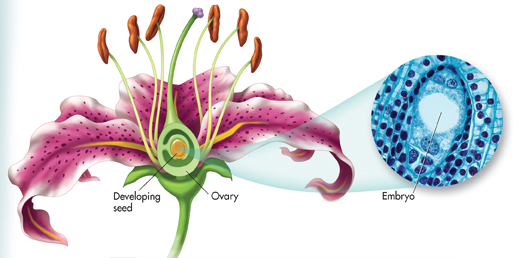22.4 Flowering Plants
 What are the key features of angiosperm reproduction?
What are the key features of angiosperm reproduction? How are different angiosperms conveniently categorized?
How are different angiosperms conveniently categorized?
ovary • fruit • cotyledon • monocot • dicot • woody plant • herbaceous plant
Compare/Contrast Table As you read, use a table to contrast three methods commonly used to categorize angiosperms.
THINK ABOUT IT Flowering plants are everywhere. They dominate the surface of the earth and are by far the most abundant organisms in the plant kingdom. And yet they evolved much more recently than did other seed plants. What features of these plants enabled them to take Earth by storm? What are the secrets of their success?
Flowers and Fruits
 What are the key features of angiosperm reproduction?
What are the key features of angiosperm reproduction?
Flowering plants, or angiosperms, first appeared during the Cretaceous Period, about 135 million years ago, making their origin the most recent of all plant phyla. Flowering plants originated on land and soon came to dominate Earth's plant life. Angiosperms make up the vast majority of plant species.
Angiosperms develop unique reproductive organs known as flowers, as shown in Figure 22–18. Flowers contain ovaries, which surround and protect the seeds. The presence of an ovary gives angiosperms their name: Angiosperm means “enclosed seed.”  Angiosperms reproduce sexually by means of flowers. After fertilization, ovaries within flowers develop into fruits that surround, protect, and help disperse the seeds. In Chapter 24, you will explore angiosperm reproduction in more detail.
Angiosperms reproduce sexually by means of flowers. After fertilization, ovaries within flowers develop into fruits that surround, protect, and help disperse the seeds. In Chapter 24, you will explore angiosperm reproduction in more detail.

FIGURE 22–18 Anatomy of a Flower Within a flower, one or more ovaries develop into fruits that surround, protect, and help disperse the seeds.

Table of Contents
- Formulas and Equations
- Applying Formulas and Equations
- Mean, Median, and Mode
- Estimation
- Using Measurements in Calculations
- Effects of Measurement Errors
- Accuracy
- Precision
- Comparing Accuracy and Precision
- Significant Figures
- Calculating With Significant Figures
- Scientific Notation
- Calculating With Scientific Notation
- Dimensional Analysis
- Applying Dimensional Analysis




